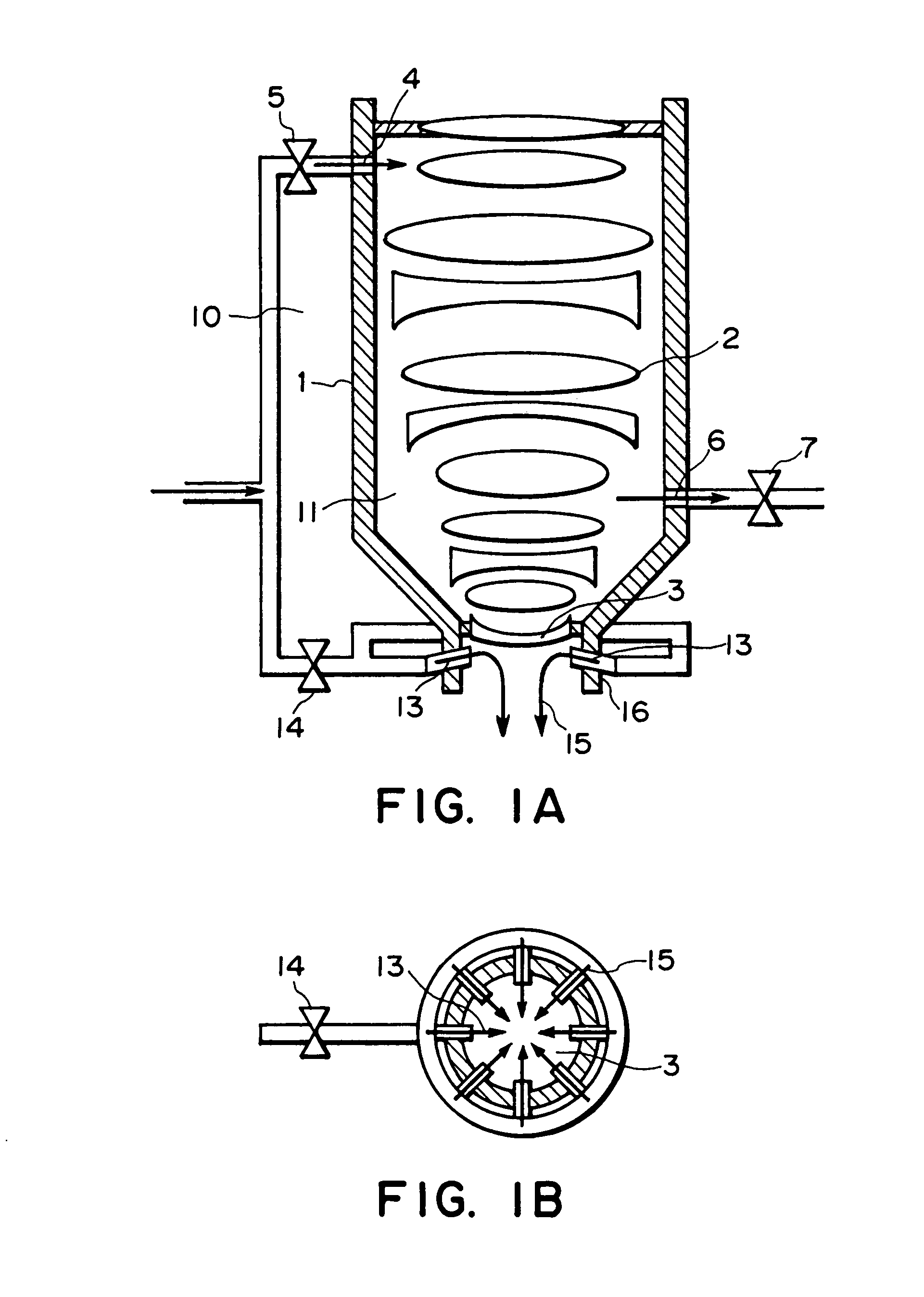Contamination prevention in optical system
a technology of optical system and contamination prevention, applied in the field of optical structure, can solve the problems of difficult to completely remove impurity gases, difficult to separate only the light path from the surrounding ambience, and difficult to purge the entire path of exposure light, so as to prevent adhesion of depositions, prevent contamination of optical elements, and keep the surface clean
- Summary
- Abstract
- Description
- Claims
- Application Information
AI Technical Summary
Benefits of technology
Problems solved by technology
Method used
Image
Examples
embodiment 1
[0066]FIGS. 1A and 1B are schematic views of a first embodiment of the present invention. This is a typical example of the present invention as applied to a bottom lens of a projection system in a semiconductor exposure apparatus. FIG. 1A is a schematic and sectional view of a projection barrel and FIG. 1B is a schematic view of the bottom of the barrel.
[0067]As shown in FIG. 1A, the projection system of the semiconductor exposure apparatus comprises a plurality of lenses 2. The whole optical system is accommodated in a barrel 1 which is closed (and purged) so that an ambient gas in a chamber ambience enters into the barrel. Along the light path, the top of the projection system, that is, the lens closest to a reticle, and the bottom of the projection lens, that is, the lens 3 closest to a wafer, serve to intercept the ambience.
[0068]The barrel is provided with a gas supply port 4 and a gas discharging port 6 so that a clean gas without containing impurities can be supplied to the i...
embodiment 2
[0078]FIG. 4 is a schematic view of a second embodiment of the present invention. In the gas supplying method of the first embodiment, there may be cases wherein, depending on the size or shape of the lens, for example, the gas that flows form the lens to the wafer surface is diffused of a resist gas. In consideration of it, as shown in FIG. 4, a gas discharging port 17 may be provided below the supply port. This is effective to produce a gas flow.
[0079]Also, in this case, there may be a plurality of gas discharging ports disposed revolutionally symmetrically with respect to the optical axis, like the gas supply ports.
[0080]Further, the shape and position of these gas supply ports and gas discharging ports should be determined so that the gas flows appropriately. Moreover, the gas supplying pressure and flow rate as well as the gas discharging pressure from the gas discharging port should be adjusted appropriately. The pressure inside the projection barrel is maintained constant, an...
embodiment 3
[0081]FIGS. 5A and 5B are schematic views of a third embodiment of the present invention, wherein FIG. 5A is a schematic and sectional view of a projection system lens barrel and FIG. 5B is a schematic view of the lens bottom face.
[0082]A gas supply port 18 and a gas discharging port 20 are provided in the neighborhood of the bottom-most lens of the projection system, that is, the lens 3 closest to the wafer, and the lens surface of the barrel 22 at the top of the projection system, facing the chamber ambience side, such that a clean gas is caused to flow. As shown in FIG. 5B, the gas supply port 18 is provided at one of lens side faces while the gas discharging port 20 is provided at the opposite lens side face, by which an effective gas flow is produced locally upon the lens surface. Particularly, plural gas supply ports and plural gas discharging ports may preferably be provided. On that occasion, a gas flows uniformly along the lens surface.
[0083]Further, in accordance with the ...
PUM
| Property | Measurement | Unit |
|---|---|---|
| wavelength | aaaaa | aaaaa |
| wavelength | aaaaa | aaaaa |
| wavelengths | aaaaa | aaaaa |
Abstract
Description
Claims
Application Information
 Login to View More
Login to View More - R&D
- Intellectual Property
- Life Sciences
- Materials
- Tech Scout
- Unparalleled Data Quality
- Higher Quality Content
- 60% Fewer Hallucinations
Browse by: Latest US Patents, China's latest patents, Technical Efficacy Thesaurus, Application Domain, Technology Topic, Popular Technical Reports.
© 2025 PatSnap. All rights reserved.Legal|Privacy policy|Modern Slavery Act Transparency Statement|Sitemap|About US| Contact US: help@patsnap.com



